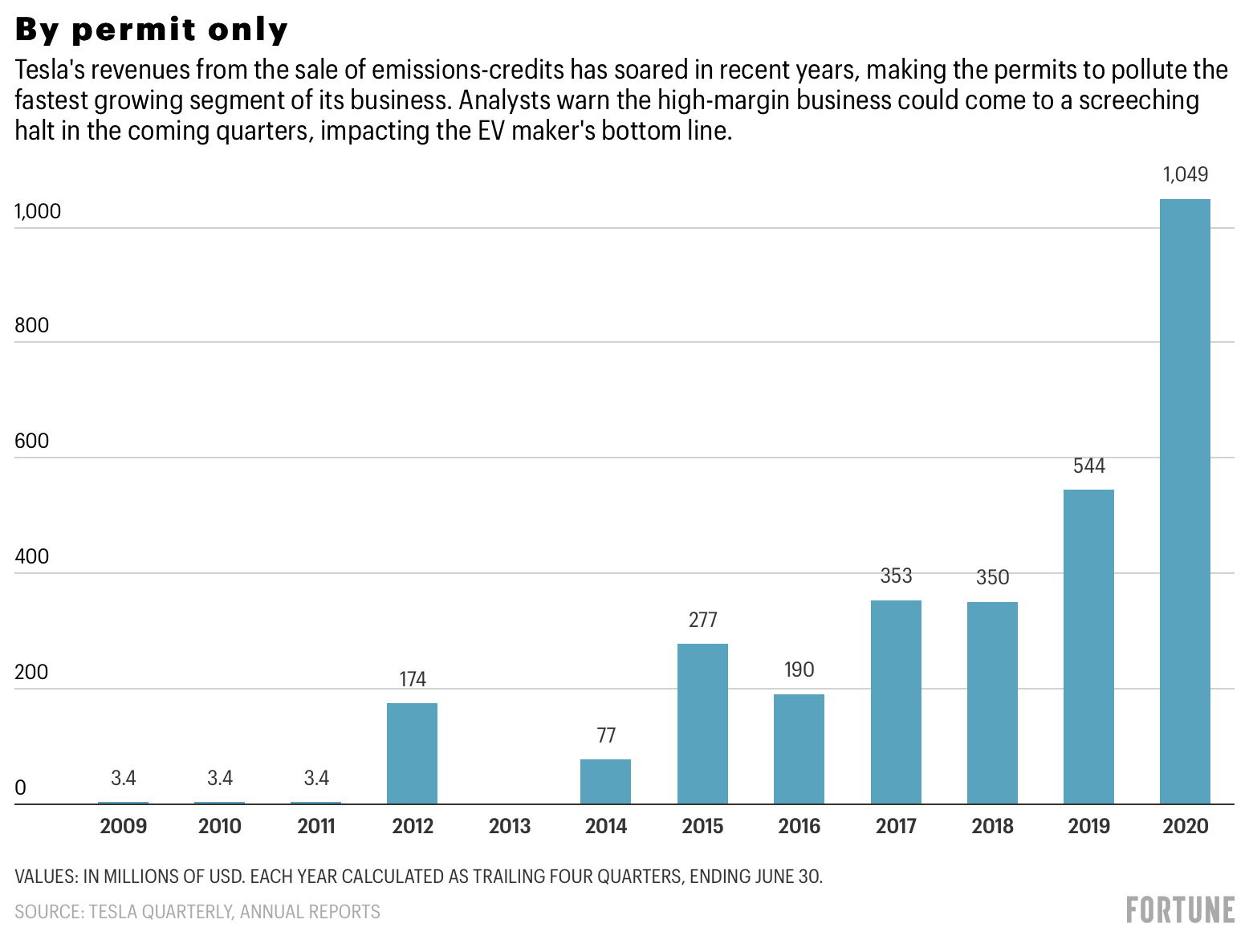 圖片來源:ILLUSTRATION BY JAMIE CULLEN
圖片來源:ILLUSTRATION BY JAMIE CULLEN多年來,一直有一個擺在眼前的“公開的秘密”,大家卻很少談論:特斯拉并不靠賣車賺到大錢。相反,特斯拉精明地利用了對銷售全球碳排放積分的復雜市場的掌控來盈利。據《財富》雜志此前的詳細報道,特斯拉的積分銷售額一開始很小,2011年之前平均每年為340萬美元,但到2020年6月30日為止的最后四個季度,這一數字增長到了10.49億美元。

總結來說,特斯拉從四個主要來源積累可交易積分(tradable credits)。第一類來自各州,特別是加州實施的零排放車輛(ZEV)計劃。另外兩項都是美國聯邦標準:美國環境保護署實施的溫室氣體(GHG)排放規定,以及美國國家公路交通安全管理局制定的企業平均燃油經濟性(CAFE)規定。最后一項則是歐盟的二氧化碳排放目標。
CAFE誕生于1978年石油危機期間,它為制造商所有的車型系列設定了平均每加侖行駛里程的年度標準。2007年美國最高法院的一項裁決將二氧化碳定為污染物,美國環保署由此被賦予了監管車輛的權力。GHG則規定了汽車制造商每輛車的二氧化碳排放量的處罰界線。這兩個項目都要求汽車制造商從2012年開始遵守相關規定。同年,他們也開始向超過基準的制造商發放類似ZEV的積分。
在這兩個項目中,特斯拉每生產一輛車就可以獲得最高碳排放積分,因為它的汽車既不消耗汽油,也不排放二氧化碳。因此,特斯拉所獲積分會隨著汽車生產而平穩上升。消費者對其積分的需求也隨著特斯拉生產更多的異形卡車和SUV而增加。特斯拉的積分增長和客戶赤字緊密連接,所以其用CAFE和GHG信用進行長期交易——與起伏不定的ZEV銷售收入相比,后者產生的收入更穩定。
在美國前總統奧巴馬的領導下,CAFE和GHG的規定變得更加嚴格,強制要求每年提高5%的燃油經濟性(fuel economy),同時降低二氧化碳的排放克數。然而,特朗普政府將要求降低到每年僅提高1.5%。如果這一政策繼續奏效,則意味著大多數汽車制造商在未來將不需要增加碳排放積分的購買,反而有可能減少。
環境經濟學家、田納西大學助理教授本·利德說:“加州的情況則完全不同,加州就像一個不同的國家。”奧巴馬的規定對汽車制造商施加了很大壓力,要求它們購買更多的積分。考慮到標準的回落,這種壓力預計在未來幾年會有所緩解。因此,他預測,2021年以及未來幾年,碳排放信用的價格,甚至是銷量都或將下降。
如果目前的規則保持不變,特斯拉很可能會看到其CAFE和GHG收入持續下降。與出現峰值后急劇下滑的ZEV形成對比,CAFE及GHG的下降應該是漸進的。
但新一屆政府可能會顛覆這一局面。如果拜登當選總統,并恢復這些激進的目標,這將極大地促進CAFE和GHG的銷售。在他的《氣候變化和環境正義計劃》中,拜登引用了他在奧巴馬政府時期提高CAFE的提議,暗示他一旦當選,將推動恢復甚至加強這些標準。要做到這一點,在說服特朗普撤銷之前,他需要從那些最初同意奧巴馬規定的汽車公司那里買進。如果他不能得到汽車制造商的同意,他可能需要訴諸法律——加強溫室氣體排放規則需要修改《清潔空氣法》。因此,如果拜登以壓倒性的優勢贏得總統職位,保持眾議院多數席位,并在參議院中獲勝,汽車制造商可能會被迫購買更多的特斯拉積分,以規避巨額罰款。然而,對特斯拉來說,這只是一個短期的優勢:這一更為嚴格的制度還將迫使汽車制造商加快轉向電動汽車的步伐。
與此同時,在歐洲,出售碳排放積分的紅利可能已經行將結束。特斯拉歐洲最大的積分買家是吉普、菲亞特、瑪莎拉蒂和阿爾法·羅密歐的制造商菲亞特克萊斯勒集團(FCA)。但FCA計劃從2020年到2022年推出多款混合動力、插電式和電動汽車,包括新版的Jeep Renegade SUV,以及菲亞特500的全電動新車型。FCA的領導人公開表示,他們希望汽車制造商到2022年能夠遵守新規定,這意味著它將不再需要特斯拉的積分。此外,2019年底,FCA同意與更注重環保的標致合并,預計明年完成合并工作。
但即便是白宮的環保人士也只會為特斯拉“爭取一些時間”,而不是“保護它目前的利潤”。CAFE和GHG的收入最終將屈服于日益激烈的競爭:大約從2023年開始,來自福特等制造商的新電動汽車的大量涌入,將使它們的產品更接近完全達標,從而減少它們對特斯拉積分的購買。
在那之后,特斯拉似乎只能通過最傳統的方式來繼續實現盈利——賣車。(財富中文網)
編譯:楊二一
多年來,一直有一個擺在眼前的“公開的秘密”,大家卻很少談論:特斯拉并不靠賣車賺到大錢。相反,特斯拉精明地利用了對銷售全球碳排放積分的復雜市場的掌控來盈利。據《財富》雜志此前的詳細報道,特斯拉的積分銷售額一開始很小,2011年之前平均每年為340萬美元,但到2020年6月30日為止的最后四個季度,這一數字增長到了10.49億美元。
總結來說,特斯拉從四個主要來源積累可交易積分(tradable credits)。第一類來自各州,特別是加州實施的零排放車輛(ZEV)計劃。另外兩項都是美國聯邦標準:美國環境保護署實施的溫室氣體(GHG)排放規定,以及美國國家公路交通安全管理局制定的企業平均燃油經濟性(CAFE)規定。最后一項則是歐盟的二氧化碳排放目標。
CAFE誕生于1978年石油危機期間,它為制造商所有的車型系列設定了平均每加侖行駛里程的年度標準。2007年美國最高法院的一項裁決將二氧化碳定為污染物,美國環保署由此被賦予了監管車輛的權力。GHG則規定了汽車制造商每輛車的二氧化碳排放量的處罰界線。這兩個項目都要求汽車制造商從2012年開始遵守相關規定。同年,他們也開始向超過基準的制造商發放類似ZEV的積分。
在這兩個項目中,特斯拉每生產一輛車就可以獲得最高碳排放積分,因為它的汽車既不消耗汽油,也不排放二氧化碳。因此,特斯拉所獲積分會隨著汽車生產而平穩上升。消費者對其積分的需求也隨著特斯拉生產更多的異形卡車和SUV而增加。特斯拉的積分增長和客戶赤字緊密連接,所以其用CAFE和GHG信用進行長期交易——與起伏不定的ZEV銷售收入相比,后者產生的收入更穩定。
在美國前總統奧巴馬的領導下,CAFE和GHG的規定變得更加嚴格,強制要求每年提高5%的燃油經濟性(fuel economy),同時降低二氧化碳的排放克數。然而,特朗普政府將要求降低到每年僅提高1.5%。如果這一政策繼續奏效,則意味著大多數汽車制造商在未來將不需要增加碳排放積分的購買,反而有可能減少。
環境經濟學家、田納西大學助理教授本·利德說:“加州的情況則完全不同,加州就像一個不同的國家。”奧巴馬的規定對汽車制造商施加了很大壓力,要求它們購買更多的積分。考慮到標準的回落,這種壓力預計在未來幾年會有所緩解。因此,他預測,2021年以及未來幾年,碳排放信用的價格,甚至是銷量都或將下降。
如果目前的規則保持不變,特斯拉很可能會看到其CAFE和GHG收入持續下降。與出現峰值后急劇下滑的ZEV形成對比,CAFE及GHG的下降應該是漸進的。
但新一屆政府可能會顛覆這一局面。如果拜登當選總統,并恢復這些激進的目標,這將極大地促進CAFE和GHG的銷售。在他的《氣候變化和環境正義計劃》中,拜登引用了他在奧巴馬政府時期提高CAFE的提議,暗示他一旦當選,將推動恢復甚至加強這些標準。要做到這一點,在說服特朗普撤銷之前,他需要從那些最初同意奧巴馬規定的汽車公司那里買進。如果他不能得到汽車制造商的同意,他可能需要訴諸法律——加強溫室氣體排放規則需要修改《清潔空氣法》。因此,如果拜登以壓倒性的優勢贏得總統職位,保持眾議院多數席位,并在參議院中獲勝,汽車制造商可能會被迫購買更多的特斯拉積分,以規避巨額罰款。然而,對特斯拉來說,這只是一個短期的優勢:這一更為嚴格的制度還將迫使汽車制造商加快轉向電動汽車的步伐。
與此同時,在歐洲,出售碳排放積分的紅利可能已經行將結束。特斯拉歐洲最大的積分買家是吉普、菲亞特、瑪莎拉蒂和阿爾法·羅密歐的制造商菲亞特克萊斯勒集團(FCA)。但FCA計劃從2020年到2022年推出多款混合動力、插電式和電動汽車,包括新版的Jeep Renegade SUV,以及菲亞特500的全電動新車型。FCA的領導人公開表示,他們希望汽車制造商到2022年能夠遵守新規定,這意味著它將不再需要特斯拉的積分。此外,2019年底,FCA同意與更注重環保的標致合并,預計明年完成合并工作。
但即便是白宮的環保人士也只會為特斯拉“爭取一些時間”,而不是“保護它目前的利潤”。CAFE和GHG的收入最終將屈服于日益激烈的競爭:大約從2023年開始,來自福特等制造商的新電動汽車的大量涌入,將使它們的產品更接近完全達標,從而減少它們對特斯拉積分的購買。
在那之后,特斯拉似乎只能通過最傳統的方式來繼續實現盈利——賣車。(財富中文網)
編譯:楊二一
For years it has been a little-talked about secret hiding in plain sight: Tesla doesn’t make much of its money selling cars. Instead, the company has shrewdly capitalized on mastering a complex market for selling global emissions credits. As Fortune previously examined in detail, Tesla’s credit sales started off small, averaging $3.4 million per year through 2011, and rising to $1.049 billion through the last four quarters ended June 30, 2020.
To sum it up, Tesla amasses tradable credits from four main sources. The first category is zero-emission vehicle (ZEV) programs run by the states, notably California. It also benefits from two U.S. federal standards, the greenhouse gas (GHG) emissions regulations imposed by the Environmental Protection Agency, and corporate average fuel economy (CAFE) rules established by the National Highway Traffic Safety Administration. The fourth is the European Union’s CO2 emissions targets.
CAFE was born during the oil crisis of 1978 and sets annual average miles per gallon standards that a manufacturer must meet for its entire fleet. GHG arose from a 2007 Supreme Court decision that designated CO2 as a pollutant, and hence gave the EPA authority to regulate vehicles. GHG establishes a limit for the amount of CO2 per vehicle a manufacturer’s fleet can emit before triggering penalties. Both programs, which closely coordinate their regulations, required that automakers start complying in 2012. That same year, they also began awarding ZEV-like credits to manufacturers that exceeded the benchmarks.
Under both programs, Tesla earns maximum credits for every car it produces, since its vehicles neither consume gasoline nor spew CO2. In fact, the credits it receives rise smoothly with production. Its customers’ need for credits rises in parallel as they make more noncompliant trucks and SUVs. Since Tesla’s credits and its customers’ deficits run in tandem, Tesla trades its CAFE and GHG credits on long-term contracts that produce more consistent, though in the past smaller, revenue than the inflow from lumpy ZEV sales.
Under President Obama, the CAFE and GHG rules got a lot stricter, mandating 5% annual increases in fuel economy and a like decline in grams of CO2. But the Trump administration rolled back the requirements to yearly improvements of just 1.5%. If it remains in effect, that downshift means that most carmakers posting shortfalls won’t need to increase their purchases of credits in the future, and may buy fewer of them.
“This is totally different from California, which is like a different country,” says Ben Leard, an environmental economist and an assistant professor at the University of Tennessee. “The Obama rules were putting a lot of pressure on carmakers to buy more credits.” That pressure is expected to ease in the years ahead, given the rollback in standards. As a result, he predicts that the price of credits, and possibly the volumes sold, will decrease in 2021 and the years ahead.
If the current rules hold, Tesla is likely to see its CAFE and GHG revenues fall going forward. The decline should should be gradual, in contrast to ZEV, which should see a spike followed by a steep slide starting in a couple of years.
But a new administration could flip that script. If President Biden were to restore the aggressive targets, it would be a huge boost CAFE and GHG sales. In his “Plan for Climate Change and Environmental Justice,” Biden cites his pride in raising the CAFE mileage requirements during the Obama administration, implying that he’d push to revive or even tighten those standards as President. To do so, he’d need a buy-in from the auto companies that initially agreed to the Obama rules before convincing Trump to roll them back. If he doesn’t get carmakers to agree, he’d likely need to resort to legislation. And toughening the GHG rules requires amending the Clean Air Act. So if Biden wins the presidency in a blue sweep, keeps the House majority and wins the Senate, automakers will probably be forced to buy a lot more of Tesla’s credits to skirt big fines. That’s only a short-term benefit, however. The stricter regime will also force the manufacturers to accelerate their move to electric cars.
Meanwhile in Europe, the glory days of selling carbon credits may already be numbered. There, Tesla’s biggest buyer of credits has been FCA, maker of Jeep, Fiat, Maserati, and Alfa Romeo. But FCA plans to launch a number of hybrids, plug-ins, and EVs from 2020 to 2022, including new versions of the Jeep Renegade SUV, as well as the new all-electric version of the Fiat 500. FCA’s leaders have stated publicly that they expect the automaker to be compliant with the new rules on its own by 2022, implying that it will no longer need Tesla. At the end of 2019, FCA agreed to merge with the much greener Peugeot, a deal expected to close next year. That union could bring FCA in line still earlier.
But even an environmentalist in the White House will only buy Tesla some time, rather than preserve its current flood of profits. CAFE and GHG revenues will eventually succumb to the blow of increased competition: Starting around 2023 an influx of new EVs from manufacturers like Ford will bring their fleets closer to full compliance, reducing their purchases of Tesla credits relative to the past.
After that, it appears Tesla will have to reach profitability the old-fashioned way: by selling cars.






